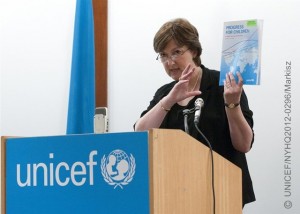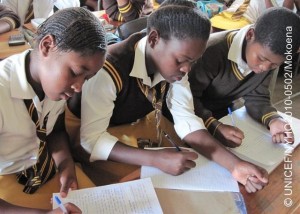联合国儿童基金会《儿童进展报告》 全球数百万青少年发展受压 非洲情况尤其严峻
2012-04-24

纽约/香港,2012年4月24日——过去20年,教育及公共衞生项目上的进步,改善了不少青少年的生活。但根据联合国儿童基金会(UNICEF)最新发表的《儿童进展报告:青少年报告》(Progress for Children: A report card on adolescents)指,在世界各地,仍有众多青少年的需要仍然备受忽略,促使每年多逾100万名青少年丧生、数以千万计的青少年失学。
举例说,报告指出,纵观全球,撒哈拉以南的非洲地区是现今青少年发展最恶劣的地区。区内青少年人口不断增长,预计到2050年,该区将成为全球青少年人口最高的地方。然而,现时当地儿童的小学毕业率仅得五成,青年就业率亦属偏低。
《儿童进展报告:青少年报告》亦警告,全球合共多达12亿名青少年(根据联合国的定义,青少年是指介乎10至19岁的人士),由于各地发展不均,遂衍生出种种棘手问题。
「贫穷、社会地位低、性別不平等或肢体残障,导致数以百万计的青少年无法平等获取优质教育、医疗服务及参与社会事务的权利。」UNICEF副执行主任Geeta Rao Gupta女士表示:「这份全面的报告有助我们找出最贫困、处于最弱势的青少年,认清他们问题所在。大家是时候正视他们的需要,决不能再置之不理。」
![(Left-right) Azara Mohammed, 14, and Humu Baba, 13, visit a guinea-worm containment centre in the town of Savelugu, capital of Savelugu-Nanton District in Northern Region. Both children were previously infected with guinea-worm disease, a painful and debilitating infection caused by a parasite ingested through drinking contaminated water. Children under 16, who are more likely to play in or drink from infected water sources, are most affected. [#1 IN SEQUENCE OF TWO] In September 2008 in Ghana, economic growth and government reforms continue to improve the lives of children and families. The country is on track to achieve several United Nations Millennium Development Goals (MDGs). However, progress is uneven. The northern regions, which account for half of the countrys population living below the poverty line, are the most impoverished, and there are wide regional and rural/urban disparities in child and maternal mortality. And while 78 per cent of the entire population has access to improved drinking water sources and 60.7 per cent have access to improved sanitation, the north lags well behind these percentages. Working with the Government and other partners, UNICEF supports health, nutrition, education and protection interventions, as well as a range of integrated water, sanitation and hygiene (WASH) interventions, including to eradicate guinea-worm disease in endemic districts.](/wp-content/uploads/2015/12/0424_PRC12_boys-300x214.jpg)    |
年少结婚产子有碍少女身心发展 报告亦提出,各界必需投放更多资源,改善青少年各方面的生活及福利,以至他们的生存所需。现时每年有140万名青少年死于交通意外、妊娠或分娩并发症、自杀、爱滋病和暴力事件等事故。在某些拉丁美洲国家,与道路交通伤亡及自杀相比,有更多的少男是死于兇杀案;在非洲,妊娠和分娩并发症则是15至19岁少女的头号杀手。 而儿童由踏入青少年阶段开始,他们面对的最大威胁,亦随之由疾病及营养不良问题,转化为暴力问题,当中少女尤其容易受婚姻暴力所伤害。根据一项在刚果民主共和国进行的调查,7成年龄介乎15至19岁的受访已婚少女表示,她们曾遭受过现任或前任伴侣暴力对待。 更甚者,青少年,特別是少女,很多时都被迫提早放弃童年,担起成年人的责任。这不但扼杀了他们学习及成长的机会,更置他们的健康与人身安全于凶险。 报告指出,在中国以外的发展中国家,多逾1/3年龄介乎20至24岁的妇女,早在18岁时已结婚或同居,而当中约1/3人的结婚年龄更早至15岁。至于,拉丁美洲、加勒比及撒哈拉以南的非洲区内的青少年生育率亦处于甚高水平。在尼日尔,多达半数20至24岁的少女,18岁前已经产子。 中学入学率持续偏低 在教育发展方面,全球小学入学率虽已平均达到90%,不少国家更正努力扩展中学教育,然发展中国家的中学入学率依然处于低水平。其中尤以非洲及亚洲情况最为严重,当地许多中学适龄学童仍然就读小学,在撒哈拉以南的非洲地区,中学入学率更位列全球最尾。 目前全球约有7,100万名中学适龄学童失学,另有1.2亿名15至24岁的青少年属文盲,他们大部分集中在南亚和撒哈拉以南的非洲地区。 |
年轻人同时是带动社区转变的骨幹,相关项目及政策除了要保护儿童及青少年外,还要给予他们发展潜能的机会,让他们能够巧用自身的想像力、创意和活力,解决种种疑难。


按此阅读报告全文 (只提供英文版本) 按此了解全球青少年概况









